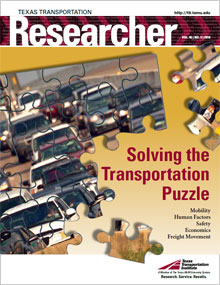
Business and individual needs for product delivery continue to evolve due to technological advancements, economic globalization, increasing competitiveness and changing market demand. The Texas Transportation Institute (TTI) is investigating innovative solutions that support the use of multiple modes of transportation, facilitate freight transfer, reduce traffic congestion, improve air quality, and provide alternative fuel and funding options.
“Freight transportation is a dynamic environment, and innovations that result in higher efficiency or lower costs quickly change the way freight moves,” says Steve Roop, assistant agency director of TTI. “Nobody likes to pay to transport freight, so low-cost solutions have a considerable potential return on investment.”
Despite rapid incremental changes in freight transportation, significant innovations are rare. Major changes in freight shipments have materialized only every 50 years or so — horse and wagon to railroads to motorized vehicles to just-in-time deliveries. According to the 50-year theory, the next major change is due, and TTI research has identified a key candidate — the Freight Shuttle.
TTI‘s Freight Shuttle concept consists of electric vehicles running on specialized guideway rails. An automated control system with few moving parts and no onboard drivers transports cargo containers along the rails. The Freight Shuttle system is a natural complement to trucking, water and rail operations, serving as a short-distance shipping partner as well as a long-distance option.
“The Freight Shuttle will produce two public revenue streams,” says Roop. “The first comes from leasing public facilities and right-of-way, and the second is from resources saved by reducing pavement damage, decreasing maintenance and relieving congestion. The public also benefits through improved safety and air quality.”
TTI researchers are also working with the Texas Department of Transportation and other sponsors on projects to discover further innovative multimodal freight solutions, such as improved grade-crossing warning systems, tank-car placards, alternative fuels and emissions-reduction strategies.
Another way to prevent potential freight-movement disruptions is through balancing transport across transportation modes and regional boundaries. An upcoming TTI project being undertaken in cooperation with the National Center for Freight and Infrastructure Research and Education at the University of Wisconsin-Madison will look at air-cargo operations and activity levels in the 10-state Mississippi Valley Freight Coalition region. Researchers will inventory regional facilities, classify cargo types and examine market demand. The project team will develop resources for planners to use in connecting intermodal traffic to air-cargo operations.
“This project will establish a better understanding of the air-freight system in the Midwest and, ultimately, provide a basis for a long-term strategic plan to integrate increasing air-cargo demand into a coordinated freight system,” says Jeff Borowiec, associate research scientist in TTI‘s Economics, Trade and Logistics Program.
In overland freight, truck traffic on roadways has outpaced growth of the roadways themselves, creating a need for ways to prevent congestion and unpredictability of deliveries. In response to the growing number and size of trucks on Texas roads, current TTI projects are exploring management of oversize and overweight truck loads. Other possible solutions include onboard warning systems and advances in highway design in primary truck corridors.
For waterborne freight, a critical component of the freight circulation system, TTI researchers are looking for ways to capitalize on the benefits of waterborne transportation, including air-quality credits for low emissions and ways to maximize the use of unused waterway capacity.
“Achieving a proper balance of road, water, rail and air transportation that moves freight most efficiently will be important in the coming years,” says Curtis Morgan, manager of TTI‘s Multimodal Freight Transportation Program.
Whether it travels by road, rail, water or air, freight that moves safely, efficiently and cost-effectively keeps our state and national economies thriving. TTI research is providing a basis for future innovations that will move freight quickly and safely, and serve individuals and businesses dealing with rapidly changing economic and social needs.

Commentary on Freight Movement
Randy Mullett
Vice President for Governmental Relations
Con-way Freight
Freight movement is the lifeblood of our economy. The recent economic downturn proves that every sector depends on moving products efficiently to keep the economy itself moving forward.
Historically, the goal of increasing efficiency has been a hallmark of the freight industry as it has evolved in America. Speed, capacity and reliability were the measures of that success as technological innovation and consumer demand drove the way we shipped products. As the world’s economies have become more interdependent, new markets have developed, bringing with them both opportunities and challenges. The opportunities are obvious; the challenges less so.
For example, different countries have different weight regulations for goods crossing national borders. Freight packaged and loaded one way in China must be repackaged before entering the United States and vice versa. These days the inefficiencies in the system are less related to technology than policy. In fact, thanks to advances in information technology, innovations like just-in-time inventories allow us to invest dollars in research and development instead of renting warehouses.
The near future will see significant changes in the way freight moves. Rising middle classes in China and India will create huge markets for U.S. manufacturers. Our previous example of packaging and repackaging goods is an unacceptable inefficiency if we’re to fully exploit those markets. Further, the intersection of shifting markets, climate change and technological innovation challenges us to find a better way to move goods.
Moving freight is and will continue to be vital to our way of life. Good policy depends on decision makers having reliable research by unbiased agencies like the Texas Transportation Institute. These data are critical to shaping sensible regulations aimed at maximizing opportunity, preserving safety and creating market share. We have the rare opportunity to know with some certainty the role freight movement will play in the next few decades. Shaping that future begins in the present.
